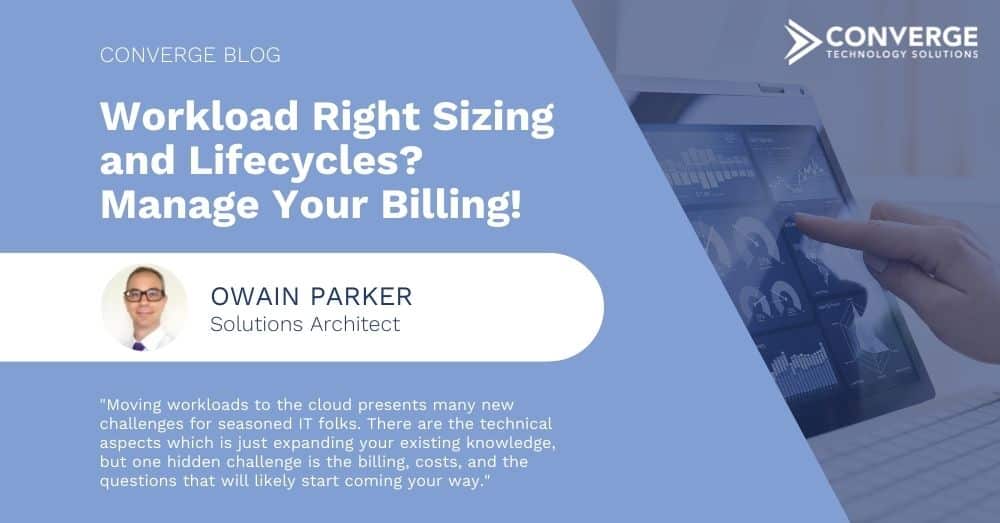Moving workloads to the cloud presents many new challenges for seasoned IT folks. There are the technical aspects which is just expanding your existing knowledge, but one hidden challenge is the billing, costs, and the questions that will likely start coming your way. Today I’m going to cover some things to consider, to help you navigate your new billing role, and mechanisms to help manage the costs and questions.
Right size first
This all may seem obvious, but the tendency when we are dealing with an on-premises infrastructure, with owned hardware, is to overprovision. That way, no one will complain about performance. It gives everyone involved an easier life. In the cloud however, overprovisioning means overpaying! Have you ever been told that the SQL server MUST have 16 cores, only to check it and see it’s not even breaking a sweat?
If you are moving workloads to the cloud, many tools can be leveraged to measure performance and provide a data driven approach to actual CPU and RAM utilization. This ensures workloads are sized correctly, or more importantly costed correctly, based on their needed performance, not just how they have been configured to this point.
And it’s not just CPU and RAM. That 2TB disk that’s 40% full? Shrink it! Its half the cost to provision a 1TB disk than a 2TB disk with a cloud provider. You can always make it bigger later. Again, it may seem obvious, but in the on-premises world of thin provisioning and oversubscribing, the perceived cost doesn’t change so it’s the easy path. With cloud, it’s the costly path!
And keep on checking….
Great job right sizing your workloads, but the work doesn’t stop there! It should be made a part of your general housekeeping processes, to regularly validate that the size is still appropriate. Again, tooling can help here. Having tooling that just keeps an eye on everything and measures it, provides recommendations, makes this an easy option to adopt and gives you monetary benefits. That data driven approach also helps remove any emotional pushback to resizing efforts.
Lifecycle of workloads
Who owns that server? Do we still need it? First off, don’t migrate unneeded workloads to the cloud, but like right sizing, it also needs to become a regular activity. Everything should have an “owner” who is ultimately responsible for determining its continued need. The “owner” might be an individual, a department or even a 3rd party, but someone must be responsible. Any individual workloads lifecycle can be verified quarterly, annually, or whatever is appropriate for your organization. Just make sure the question of if its needed or not gets asked!
Metadata is your friend
Great, the workload has been right sized, it’s got an owner, now what? Attach that information to the workload! Use the tagging capabilities of the cloud provider to keep that data in a commonly accessible location. You can store the owner in here. You can store the date it was reviewed or right sized. You can store your mums birthday in there if you want! Make tags that work for you. Aligned them to your organization, what’s important to you. You set the rules and are responsible for inputting and updating them. Just make sure you update your processes and set the expectation with anyone managing the cloud workloads to keep them current and accurate.
Reports, and the power of that metadata
You’ve just got a bill! Now the power of tags can be realized. You can add color to the bill data. Cut up the bill to represent departments, spread the cost responsibility. Charging within the organization isn’t appropriate for every organization, but visibility of costs should at least be encouraged.
What workload lifecycles do we need to review and get validation for this quarter? You’ve got that data in the tags! Use it, export it, even drive automation to ask the owner to positively confirm its need is still valid.
Now you’re empowered!
Now if questions about costs come to you, you can show with confidence you are managing costs with regular review processes, able to show the spread and responsibility of costs, basically you’re on top of it. Great job!
Need help or guidance?
We are here to help! At Converge we are always helping our valued customers gain maximum value from their cloud adoption strategy, at every stage of the process. If you need help to right size, improve your processes, automate activities, then reach out, we’d love to get involved and help you.





